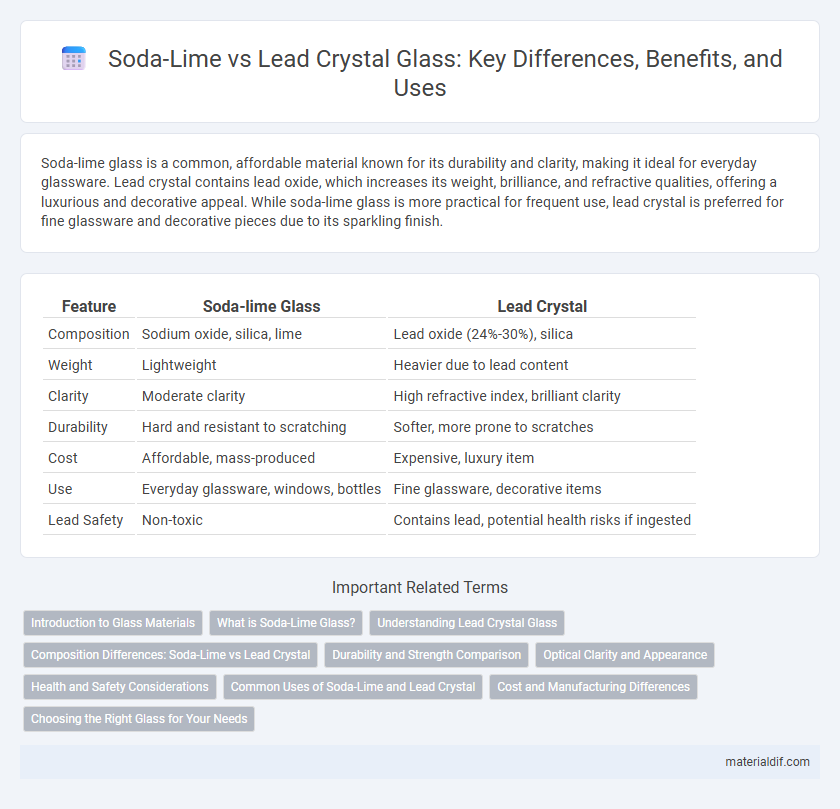Soda-lime glass is a common, affordable material known for its durability and clarity, making it ideal for everyday glassware. Lead crystal contains lead oxide, which increases its weight, brilliance, and refractive qualities, offering a luxurious and decorative appeal. While soda-lime glass is more practical for frequent use, lead crystal is preferred for fine glassware and decorative pieces due to its sparkling finish.
Table of Comparison
| Feature | Soda-lime Glass | Lead Crystal |
|---|---|---|
| Composition | Sodium oxide, silica, lime | Lead oxide (24%-30%), silica |
| Weight | Lightweight | Heavier due to lead content |
| Clarity | Moderate clarity | High refractive index, brilliant clarity |
| Durability | Hard and resistant to scratching | Softer, more prone to scratches |
| Cost | Affordable, mass-produced | Expensive, luxury item |
| Use | Everyday glassware, windows, bottles | Fine glassware, decorative items |
| Lead Safety | Non-toxic | Contains lead, potential health risks if ingested |
Introduction to Glass Materials
Soda-lime glass, composed primarily of silica, soda, and lime, is the most common type of glass used in windows, bottles, and jars due to its affordability and durability. Lead crystal glass incorporates lead oxide, enhancing its refractive index and brilliance, which makes it ideal for decorative items like fine glassware and chandeliers. The distinct chemical compositions influence their optical properties, weight, and applications in various industries.
What is Soda-Lime Glass?
Soda-lime glass is the most common type of glass, composed primarily of silica (about 70-74%), soda (sodium oxide, 12-16%), and lime (calcium oxide, 5-12%). It offers durability, affordability, and ease of manufacture, making it ideal for windows, bottles, and jars. Unlike lead crystal, soda-lime glass lacks the high refractive index and brilliance but provides better chemical stability and resistance to weathering.
Understanding Lead Crystal Glass
Lead crystal glass contains lead oxide, typically between 24% and 30%, which increases its density, brilliance, and clarity compared to soda-lime glass, the most common and inexpensive glass composed mainly of silica, sodium oxide, and calcium oxide. The addition of lead oxide in lead crystal enhances its refractive index, giving it a distinctive sparkle and weight, making it ideal for luxury glassware and decorative items. Unlike soda-lime glass, lead crystal is softer and easier to cut or engrave, contributing to its premium craftsmanship appeal.
Composition Differences: Soda-Lime vs Lead Crystal
Soda-lime glass primarily consists of silica (SiO2), sodium oxide (Na2O), and calcium oxide (CaO), making it durable and affordable for everyday use. Lead crystal contains a significant amount of lead oxide (PbO), often between 24-32%, which increases its refractive index and weight, resulting in enhanced brilliance and clarity. The higher lead content in lead crystal lowers its melting point and makes it softer and easier to cut compared to the harder, more chemically stable soda-lime glass.
Durability and Strength Comparison
Soda-lime glass, composed mainly of silica, soda, and lime, offers high durability and resistance to everyday wear, making it ideal for windows and bottles. Lead crystal, infused with lead oxide, provides superior brilliance and weight but is more fragile and prone to chipping compared to soda-lime glass. The presence of lead enhances its refractive properties but reduces overall strength, making soda-lime glass more suitable for applications requiring toughness.
Optical Clarity and Appearance
Soda-lime glass offers moderate optical clarity with a slight greenish tint due to iron content, making it suitable for everyday use but less ideal for high-end glassware. Lead crystal contains lead oxide, which significantly enhances its refractive index, resulting in superior brilliance, clarity, and prism-like light dispersion that creates a sparkling appearance. The high density and weighted feel of lead crystal also contribute to its luxurious aesthetic compared to the lighter and less visually vibrant soda-lime glass.
Health and Safety Considerations
Soda-lime glass is widely regarded as safer for everyday use due to its non-toxic composition and absence of heavy metals, reducing risk of lead exposure. Lead crystal contains lead oxide, which enhances brilliance but poses health hazards if used for food and drink, as lead can leach into consumables over time. Regulatory agencies recommend limiting lead crystal use for storage and opting for soda-lime glass in products involving direct contact with food and beverages.
Common Uses of Soda-Lime and Lead Crystal
Soda-lime glass is commonly used for everyday items such as windows, bottles, jars, and food containers due to its affordability, durability, and chemical stability. Lead crystal is predominantly used for decorative objects, fine glassware, chandeliers, and luxury tableware because of its high refractive index, brilliance, and ease of cutting. Soda-lime glass is preferred in mass production and industrial applications, while lead crystal is favored in artistic and luxury markets.
Cost and Manufacturing Differences
Soda-lime glass is more cost-effective due to abundant raw materials like silica, soda ash, and limestone, making it ideal for mass production with simple manufacturing processes such as float glass. Lead crystal incorporates lead oxide, increasing material costs and requiring precise temperature control and longer annealing times, resulting in more labor-intensive production. Consequently, soda-lime glass remains inexpensive and widely used, while lead crystal commands higher prices due to complex manufacturing and enhanced optical properties.
Choosing the Right Glass for Your Needs
Soda-lime glass is a cost-effective, durable option commonly used for everyday drinkware due to its resistance to thermal shock and chemical stability. Lead crystal offers superior clarity, brilliance, and weight, making it ideal for fine dining and special occasions where aesthetic appeal is prioritized. Consider factors such as budget, durability, and visual quality to choose between the practicality of soda-lime glass and the luxury of lead crystal.
Soda-lime vs Lead crystal Infographic

 materialdif.com
materialdif.com